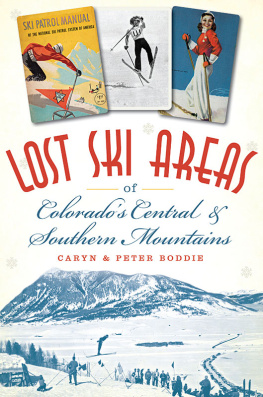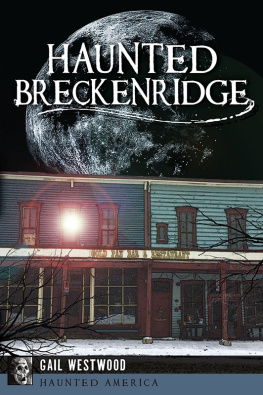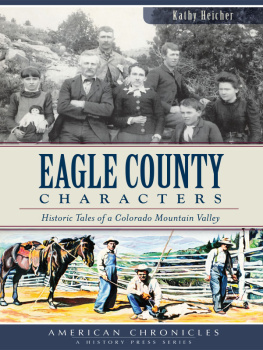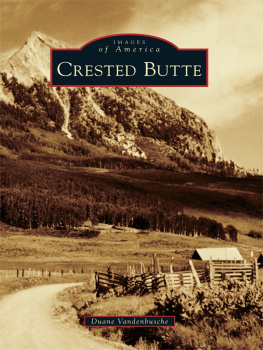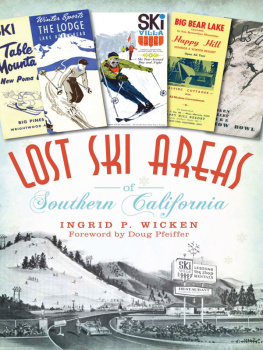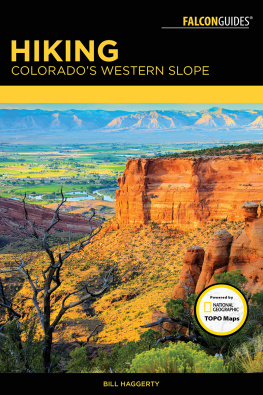

Published by The History Press
Charleston, SC
www.historypress.net
Copyright 2015 by Caryn Boddie and Peter Boddie
All rights reserved
First published 2015
e-book edition 2015
ISBN 978.1.62585.241.0
Library of Congress Control Number: 2015940375
print edition ISBN 978.1.62619.713.8
Notice: The information in this book is true and complete to the best of our knowledge. It is offered without guarantee on the part of the authors or The History Press. The authors and The History Press disclaim all liability in connection with the use of this book.
All rights reserved. No part of this book may be reproduced or transmitted in any form whatsoever without prior written permission from the publisher except in the case of brief quotations embodied in critical articles and reviews.
For the fun of skiing, for the people of skiing, for the sport of skiing, praise God.
Contents
Foreword
I got my first pair of skis for Christmas in 1961, and it was a gift that changed my life. Fifty-plus years hence, the sport of skiing has come to define me as a person like few other things do.
In the early 1960s in southwest Colorado, we had mostly ski hills rather than ski areas. The nearest chairlifts were mountain ranges away. Surface liftsmostly rope tows and T-barswere the only lifts used at places like Hesperus, Stoner, Kendall Mountain, Wolf Creek and Durangos local hill, Third Avenue (now Chapman Hill). Wooden skis, lace-up leather boots and cable bindings were the order of the day. My first set of skis, boots, bindings and poles probably cost my dad about twenty dollars.
The popularity of recreational skiing exploded in the 1960s, and we unknowingly rode the wave. Many of Colorados major resorts were founded in the 60s, including our own local ski area, Purgatory, in 1965. Purgatorys development wasnt only a quantum change in our ski experienceit transformed Durangos economy by making tourism a year-round endeavor.
Skiers of my generation, the baby boomers, came of age during what I think of as the golden age of skiingall or most of the 60s, 70s and 80s. Fueled by the baby boomers, recreational skiing remained a growth sport throughout most of that period.
While Colorados skiing roots date back to the Euro-American settlement of the state in the 1860s and 1870s, serious recreational Alpine skiing began in the 1930s, when the first ski tows were built by local ski clubs and other groups of enthusiasts. The 1932 Winter Olympics in Lake Placid and the 1936 Winter Games in Garmisch, where Alpine ski races were first held, captured Americans attention. The first rope tows in North America (Shawbridge in Quebec and Gilberts Hill in Vermont in 1934) were soon followed by the first rope tows in Colorado. Local skiers with some mechanical ability modified car and truck engines to power rope tows, and they organized local ski clubs to raise money for gas and other expenses to keep the tows operating.

Robert McDaniels official membership card for the Durango Ski Club. Courtesy Robert McDaniel.
Colorados mountain towns were suffering economically in the 1930s partly because of a declining mining industry and struggling farm and ranch operations. They promoted skiing and ski competitions in the hopes of generating some business. The efforts of local enthusiasts and ski clubs in the 1930s, 40s and 50s laid the groundwork for the boom that was to follow. People quickly learned that skiing was fun, even if they were using relatively primitive equipment, everyday clothing and improvised tows. Momentum built slowly during those Depression years, and then World War II put a damper on the sport. Even during those difficult times, however, people found a way to keep skiing.
After the war, skiing rapidly gained in popularity as a winter pastime. Ski areas popped up all across the country, from Vermont to California and Minnesota to Alabama. The best skiing, however, was in the West, and Colorado was on track to become the number-one state for recreational skiing. Colorados dominant position was due, in no small part, to the efforts of its early ski pioneers before, during and after World War II.
Looking back after nearly forty years spent in dual careers as both a historian and a professional ski patrolman, the importance of those pioneering efforts to the growth and identity of places such as Aspen, Breckenridge, Crested Butte, Telluride and Durango comes into sharper focus. In this book, youll learn about the predecessors of Colorados major resortslocal ski hills from Porcupine Gulch on the west side of Loveland Pass to places like Cowboy Hill only a few miles north of the New Mexico border.
I was lucky to have experienced the flavor of that pioneering period of lift-served skiing, even if it was toward the end of that era. Fortunately, too, there are still people living who remember using those first tows and can tell us about them. Caryn and Peter Boddie have captured some of those memories along with important information about times and places in our skiing history now almost lost to memory.
Robert McDaniel, Durango, Colorado
March 2015
Acknowledgements
We are very grateful to those who passed ski culture on to us, especially our parents, and we thank everyone who shared knowledge, memories, resources and photos with us. Special thanks go to Fred Brewer, Brad Chamberlin, Robert McDaniel, Duane Vandenbusche and Senior Mahoney. Also, a special thank-you goes to Western State Colorado University for sharing former students theses. Again, thank you all very much.
Introduction
Skiing resembles life. You start at the bottom and work your way up. Along the way you see many pretty scenes and some dim ones. You think at times you will just never make it. But there at last is the top. After taking off your climbers you have that long ride to repay your efforts.
letter to Bud Davey, 1940
This book is for you. Its the second leg of a lighthearted ski tour of the lost ski areas of Colorado. We hope reading this book will be like gliding through champagne powder on your best skis or snowboard. Enjoy! Our first book took readers to the Front Range and northern mountains. Also, it gave them a primer on the geography and snow in Colorado, and it told the story of the immigrants who brought ski culture to the state. This book will take you to the central and southern mountains and western plateaus. It will also inform you about a few things related to lost areas that we didnt cover in the first book: the National Ski Patrol, the Tenth Mountain Division and the lost Olympics.
Colorado is a great ski state with great powder. Its different regions are part of that whole and have always been alike in some ways; for example, all over the state, skiing started with folks using Norwegian snowshoes (long wooden skis) to get around in winter and then to race straight down the hill. Also, skiing began as an individual activity but quickly became community fun. In both areas, businesspeople, government workers, teachers and others joined in early skiing and made contributions to the sport and the hills.

Loggers, along with miners and tradesmen, first brought ski culture to Colorado.
Next page
